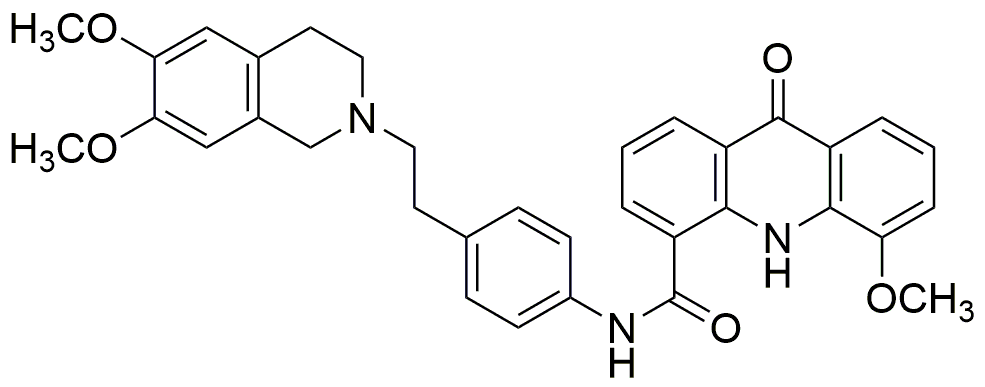Elacridar is widely utilized in research focused on:
- Pharmaceutical Development: It is used as a potent inhibitor of P-glycoprotein, enhancing the bioavailability of various drugs by preventing their efflux from cells, which is particularly beneficial in formulating medications for cancer therapy.
- Drug Combination Studies: Researchers employ Elacridar to study its effects in combination with other chemotherapeutic agents, aiming to improve treatment outcomes for resistant cancer types.
- Transport Studies: It serves as a valuable tool in pharmacokinetic studies to assess how drugs are absorbed and distributed in the body, helping scientists understand drug interactions and optimize dosing regimens.
- Neuroscience Research: Elacridar is utilized in studies examining the blood-brain barrier, aiding in the development of central nervous system-targeted therapies by evaluating how well drugs penetrate this barrier.
- Formulation Science: It is applied in the development of novel drug delivery systems, enhancing the efficacy of poorly soluble compounds by improving their solubility and stability through innovative formulation techniques.
General Information
Properties
Safety and Regulations
Applications
Elacridar is widely utilized in research focused on:
- Pharmaceutical Development: It is used as a potent inhibitor of P-glycoprotein, enhancing the bioavailability of various drugs by preventing their efflux from cells, which is particularly beneficial in formulating medications for cancer therapy.
- Drug Combination Studies: Researchers employ Elacridar to study its effects in combination with other chemotherapeutic agents, aiming to improve treatment outcomes for resistant cancer types.
- Transport Studies: It serves as a valuable tool in pharmacokinetic studies to assess how drugs are absorbed and distributed in the body, helping scientists understand drug interactions and optimize dosing regimens.
- Neuroscience Research: Elacridar is utilized in studies examining the blood-brain barrier, aiding in the development of central nervous system-targeted therapies by evaluating how well drugs penetrate this barrier.
- Formulation Science: It is applied in the development of novel drug delivery systems, enhancing the efficacy of poorly soluble compounds by improving their solubility and stability through innovative formulation techniques.
Documents
Safety Data Sheets (SDS)
The SDS provides comprehensive safety information on handling, storage, and disposal of the product.
Product Specification (PS)
The PS provides a comprehensive breakdown of the product’s properties, including chemical composition, physical state, purity, and storage requirements. It also details acceptable quality ranges and the product's intended applications.
Certificates of Analysis (COA)
Search for Certificates of Analysis (COA) by entering the products Lot Number. Lot and Batch Numbers can be found on a product’s label following the words ‘Lot’ or ‘Batch’.
*Catalog Number
*Lot Number
Certificates Of Origin (COO)
This COO confirms the country where the product was manufactured, and also details the materials and components used in it and whether it is derived from natural, synthetic, or other specific sources. This certificate may be required for customs, trade, and regulatory compliance.
*Catalog Number
*Lot Number
Safety Data Sheets (SDS)
The SDS provides comprehensive safety information on handling, storage, and disposal of the product.
DownloadProduct Specification (PS)
The PS provides a comprehensive breakdown of the product’s properties, including chemical composition, physical state, purity, and storage requirements. It also details acceptable quality ranges and the product's intended applications.
DownloadCertificates of Analysis (COA)
Search for Certificates of Analysis (COA) by entering the products Lot Number. Lot and Batch Numbers can be found on a product’s label following the words ‘Lot’ or ‘Batch’.
*Catalog Number
*Lot Number
Certificates Of Origin (COO)
This COO confirms the country where the product was manufactured, and also details the materials and components used in it and whether it is derived from natural, synthetic, or other specific sources. This certificate may be required for customs, trade, and regulatory compliance.

